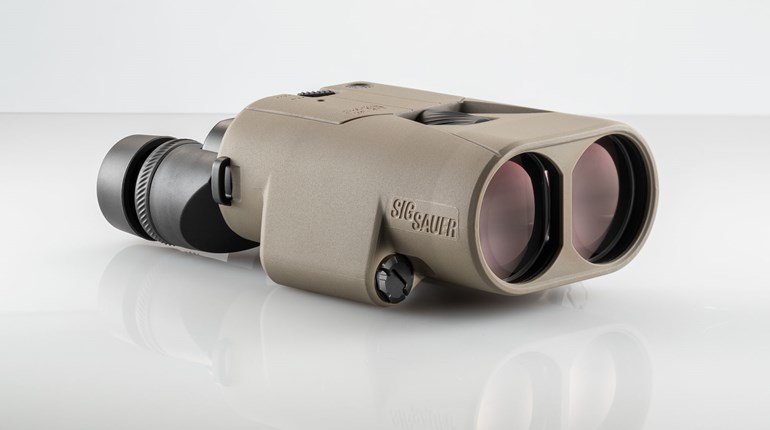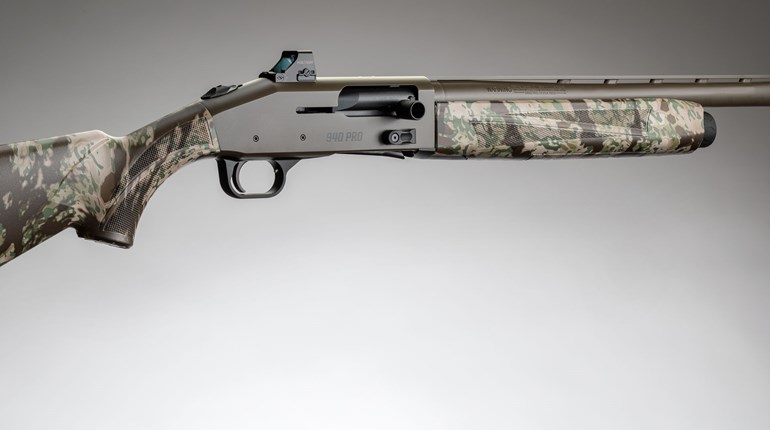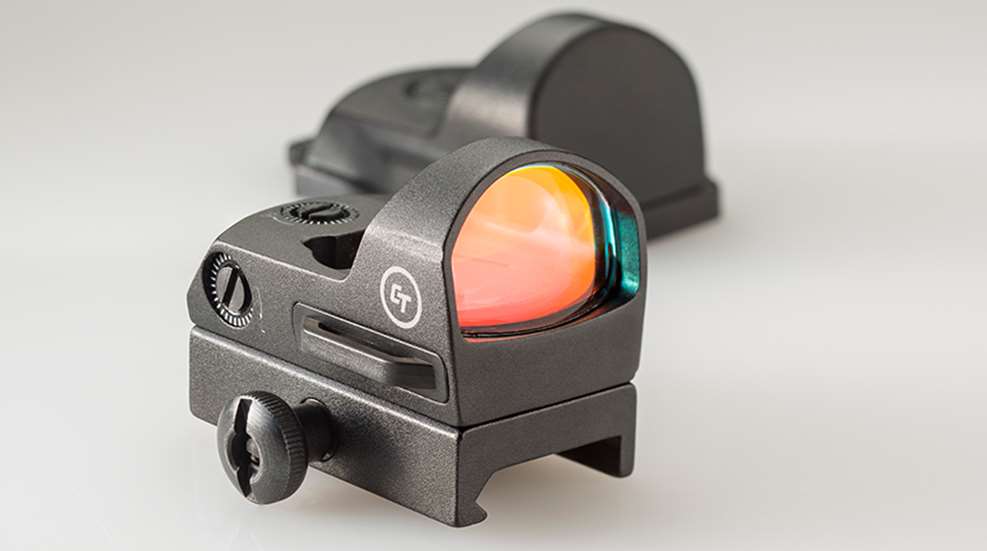
For 25 years Crimson Trace Corporation has pioneered and designed products that make aiming easier, particularly in conditions and circumstances where iron sights are difficult to see or align. The company’s best-in-class Lasergrips, Laserguard and Rail Master have shown millions of shooters the benefits of using a laser beam for aiming handguns, rifles and shotguns. While Crimson Trace laser sights can be useful for hunting where regulations permit (hogs and predators at night come to mind), they’re mainly used for self-defense, law enforcement and military applications. But this year Crimson Trace extends its product line to include electro-optics—scopes and sights that feature battery-powered, illuminated reticles—which hunters will find practical for all kinds of game. The CTS-1300 reflex sight is one of the first models in the company’s new category.
Reflex sights have become increasingly popular with hunters and shooters during the past 20 years, but they originated in the early 1900s. The principle by which they operate has remained unchanged during that time. A lens or mirror reflects a projected image of the reticle, making the reticle look like it is overlaid on the field of view. (They were first called reflector sights for this reason.) The reticle appears at, and remains in focus to, infinity, which virtually eliminates parallax. Practically speaking, the reflex sight’s typical dot reticle looks sharp on the target regardless of range, and it doesn’t shift when eye or head position relative to the sight changes.
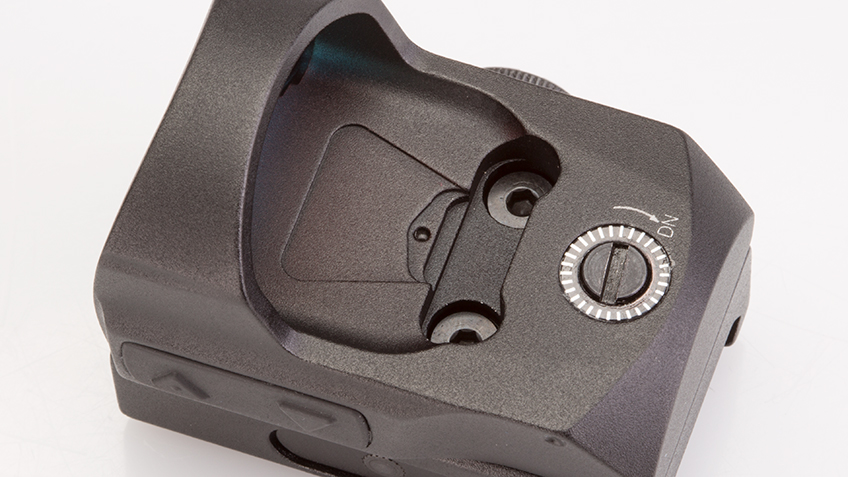
Small reflex sights like the CTS-1300 have no magnification and unlimited eye relief, and are best used while keeping both eyes open. They are excellent for snap-shooting at close-range targets on the move, such as whitetails in the brush. They also make it possible to accurately aim from awkward positions where cheek weld is far less than perfect, such as when a gobbler suddenly appears on the wrong side of the tree. All my turkey guns have reflex sights on them for this reason and because their red-dot reticles don’t obscure nearly as much of a bird’s head as iron sights.
The CTS-1300 is a compact unit—less than 2 inches long, 1.3 inches wide and 1.7 inches high including its mounting base—and it weighs less than 3 ounces. The base that comes with the sight mounts to a Picatinny or Weaver rail via a single cross-slot bolt. Both the base and the sight frame are made from anodized aluminum. Crimson Trace also supplies with the CTS-1300 a cover that fits snuggly over the entire sight but flexes for easy removal.
Like most modern reflex sights, an LED housed within the CTS-1300 projects the reticle. The 3.5-MOA dot spans roughly the width of a gobbler’s naked neck at 50 yards; it covers half that much at 25. It’s fine enough to accurately direct a pattern or bullet at longer distances but large enough to see immediately for quick shots during fleeting encounters.
The lens surfaces of the CTS-1300 are fully multi-coated and include a treatment that Crimson Trace calls a “notch filter.” Essentially the filter is a series of coatings applied to reflect light with a wavelength specific to that emitted by the red LED. By reflecting only a specific “notch” of visible light, the dot appears brighter while the view through the sight window remains natural and clear.
Two push-button triangles on the left side of the sight frame control the brightness of the LED and therefore the intensity of the dot reticle. There are seven illumination settings; press the upward-pointing triangle for a brighter reticle, press the downward-pointing triangle to decrease brightness. Pressing either of the triangles turns the LED on, and pressing and holding either for four seconds turns it off.
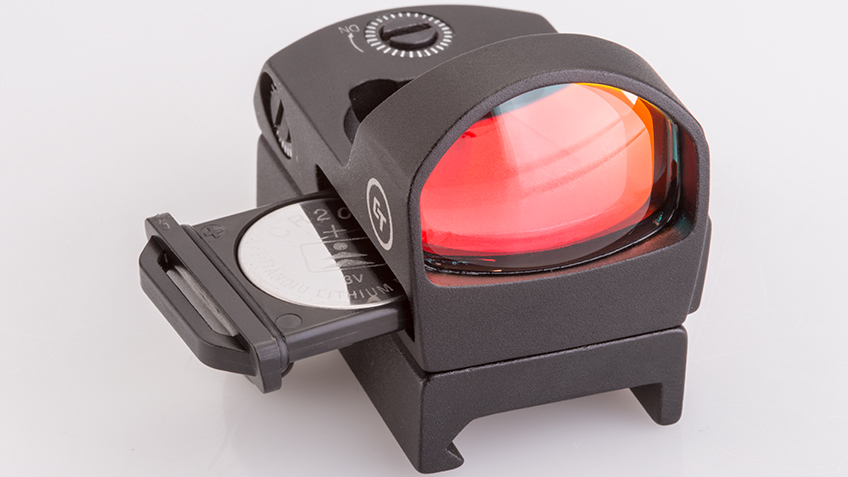
A CR2032 battery powers the LED. The battery is contained within a drawer that slides into the right side of the frame and is O-ring sealed against moisture. Having struggled to align thin, screw-in battery caps on other reflex sights, I recognize this sliding design as a huge improvement. Crimson Trace says the battery has a life of more than 15,000 hours (almost two years) under normal use. The high-efficiency LED requires little power, and the sight automatically powers down after three hours of inactivity to preserve the battery. One battery comes with the sight, and registering online with Crimson Trace entitles the owner to a replacement battery every year under the company’s “Free Batteries for Life” program.
Windage and elevation adjustments are in 1-MOA increments, which seem coarse when compared to a scope’s .25-MOA clicks but make sense for a non-magnifying reflex sight with a 3.5-MOA dot reticle. At 50 yards—a reasonable distance to zero the CTS-1300 when it’s mounted on a turkey gun or lever-action deer rifle—each click represents an adjustment of about .5 inch. Far less turning is required to move the reticle the desired distance than with finer increments. The uncapped adjustment dials have slots for turning with a flat-head screwdriver.
I subjected the CTS-1300 to one of the toughest recoil tests I know: patterning magnum turkey loads with a fairly lightweight shotgun. The adjustment dials tracked precisely, and although I couldn’t feel the clicks, I could hear them. Once the CTS-1300 was zeroed, I noticed no shift in the patterns delivered by nearly 30 rounds. Turkey targets appeared crisp through the sight window, and the dot stood out brightly against them.
Crimson Trace got its start with lasers, but with the CTS-1300 the company moves in a different direction. That’s good news for hunters, because now we, too, can take advantage of Crimson Trace’s dedication to producing reliable, easy-to-use sighting systems.
Technical Specifications
• Type: reflex optic
• Magnification: 1X
• Eye Relief: unlimited
• Reticle: 3.5 MOA illuminated red dot
• Adjustments: 100 MOA in 1-MOA increments
• Coatings: fully multi-coated
• Dimensions: length 1.88″; width 1.3″; height 1.7″; weight 2.7 ozs.
• Construction: anodized aluminum frame; water-resistant, shock-resistant; side-mounted intensity control w/7 brightness settings
• Accessories: rail mount, cover
• MSRP: $299; crimsontrace.com














